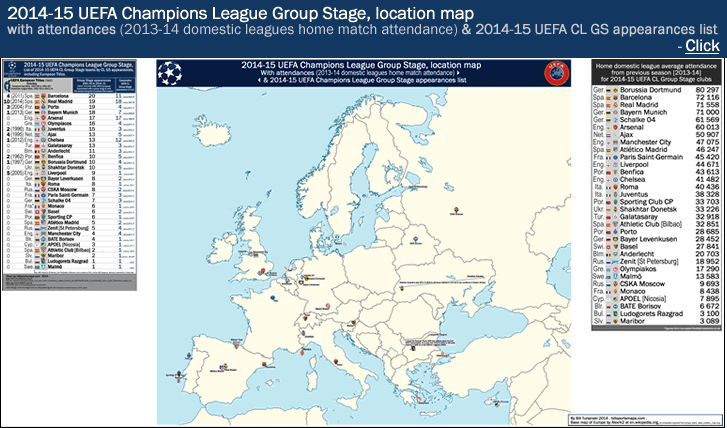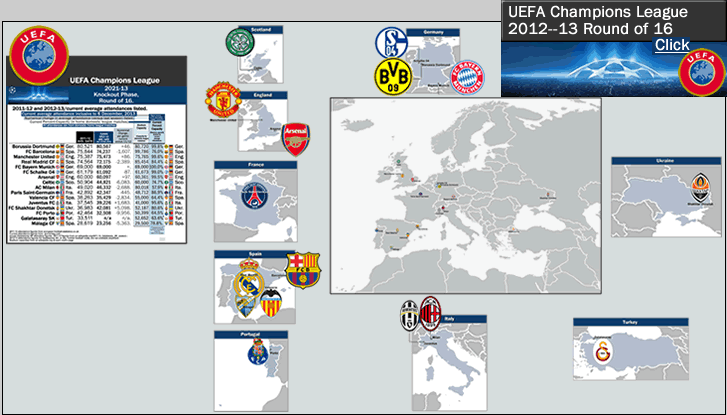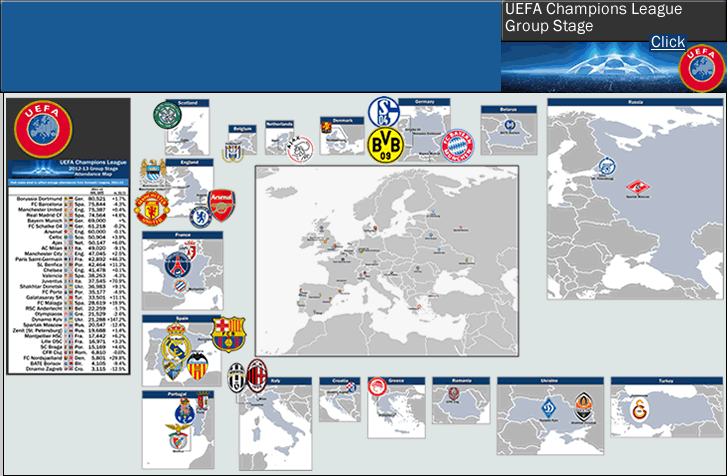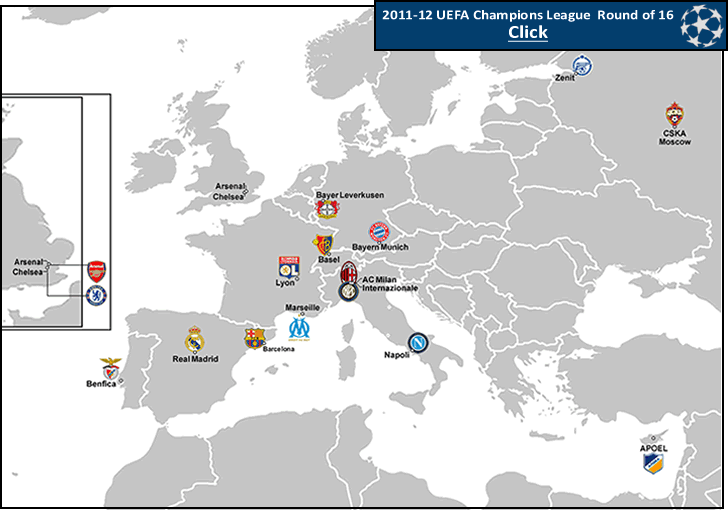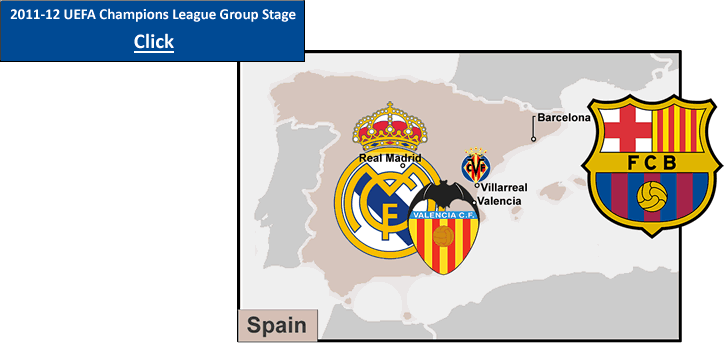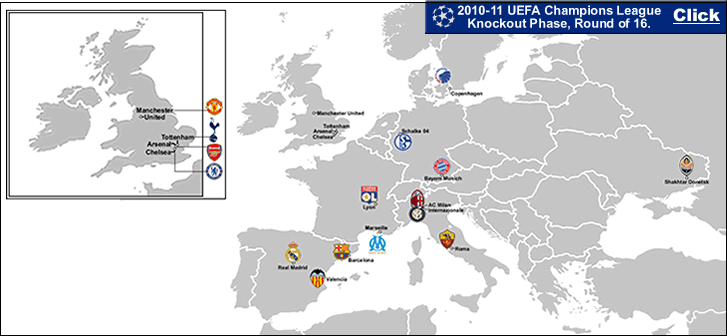
2010-11 UEFA CL, Round of 16 map
…
…
The UEFA Champions League 2010-11 Knockout Phase, Round of 16 gets underway on 15th and 16th February, with four matches; then resumes a week later for the other four 1st Leg matches. 2nd Leg matches are set for 8th and 9th / 15th and 16th March. If you want to see the 8 match-ups, with club profile boxes and 2 stadia photos for each club, scroll down a bit and click on the 2 dark blue boxes near the end of this post.
Teams that play at home for the 2nd Leg Leg were seeded higher for for the draw by winning their groups in the Group Stage. The biggest surprise in that category are Ukraine’s Shakhtar Donetsk, who finished ahead of Arsenal in their group. This is the first time Shakhtar Donetsk have made it to the Round of 16 in the Champions League. Shakhtar come from the heavily industrialized Donbass region of eastern Ukraine, from the city of Donetsk, which is a grim city built on coal mining and heavy industry, offering little in the way of the things considered to be tourist attractions. In fact, enlarging the amount of total hotel rooms in the city is one of the most pressing issues facing Donetsk when the city hosts some of the matches for UEFA Euro 2012 (which Ukraine is co-hosting with Poland in June 2012). Shakhtar Donetsk are owned by Ukraine’s wealthiest citizen, Rinat Ahkmetov, who began his rise as an oligarch in the banking sector in Donetsk in the first half of the 1990s, when newly independent Ukraine was freeing itself from the grip of Russian imperialism and setting up a system of private enterprise. Akhmetov is an ethnic Tatar/ Ukraine-born son of a Donbass coal miner, and is 42 years old. In 2000, Akhmetov founded Systems Capital Management (SCM Holdings), which has stakes in metals, coal mining, power generation, banking, insurance, real estate, telecommunications, and media. Assets of the company, 100% owned by Akhmetov, have been recently disclosed as $18 billion {SCM.com.ua/Key Financial Indicators [to 2009]‘. Akhmetov has devoted considerable sums in turning Shakhtar Donetsk from a small cup-specialist club with no national titles to a force in Ukraine and now Europe. Their futuristic new Donbass Arena (cap. 51,504) is testament to this. Shakhtar are pulling in around 33,000 per game this season in domestic home league matches, and are running away with the Ukrainian Premier League title again (they have won 4 of the last 6 Ukrainian titles). Akhmetov has undertaken this by making sure players he lured to eastern Ukraine are treated like royalty – it is common knowledge these days among football players that Shakhtar Donetsk’s facilities and infrastructure are on par with the most elite clubs in Western Europe. Shakhtar Donetsk are managed by the Romanian Mircea Lucescu, who has also coached in Turkey (winning titles for Galatasaray in 2002, and Besiktas in 2003), and in Italy (with Internazionale in 1998-99). Lucescu has managed Shakhtar since 2004. For the past few seasons, Shakhtar has been fielding around 3 to 5 Brazilians in their starting lineups in most matches. By way of example, when Shakhtar Donetsk beat Werder Bremen in Istanbul to win the 2008-09 UEFA Cup title, Shakhtar started 5 Brazilians (including goal scorers Luz Adriano and Jadson), 3 Ukrainians, 1 Croat (captain and DF Dario Srna), 1 Romanian (DF Razvan Rat), and 1 Pole (Mariusz Lewandowski). Luz Adriano, Jadson, Srna, and Rat still figure prominently in Shakhtar’s current configuration.
The crucial match which propelled Shakhtar Donetsk to the Round of 16 this season was the 3 November, 2010 match in Ukraine which saw a 2-1 defeat of Arsenal in the Donbass Arena before 51,153. This had come two weeks after Arsenal had humiliated Shakhtar by a 5-1 score at the Emirates Stadium in North London. In the 3 November match, goals for Shakhtar were scored by western Ukraine-born DF Dmitro Chygrynskiy in the 28th minute (following a 10th minute Arsenal goal by Theo Walcott), and a 58th minute winner by former Arsenal player, the Croatian international/Brazilian-born Eduardo, who looks to be recovered from his devastating leg injury in early 2008. From uefa.com, 3 Nov. 2010, ‘Eduardo strike sinks former club Arsenal’.
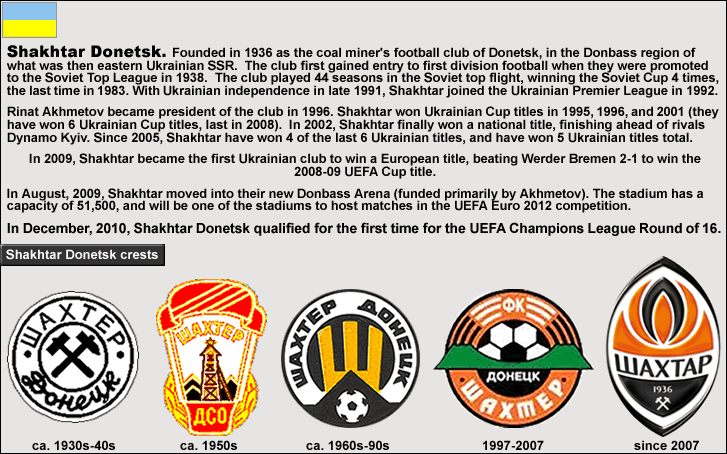
Shakhtar Donetsk have drawn AS Roma for the Round of 16. They will meet for the 1st Leg on 16 February at the Stadio Olimpico in Rome. 2nd Leg is for 8 March in Donetsk.
…
Of the 16 clubs still alive in the 2010-11 Champions League, the biggest surprise overall is the qualification of FC Copenhagen (in Danish, FC Kobenhavn). This is the first appearance in the Round of 16 for a club from Denmark. Like quite a few other football clubs in Denmark in recent history, FC Copenhagen was the result of a merger. In this case, it was between two historically successful but stagnating clubs from the country’s capital city, KB and B 1903. The two clubs had not won a Danish title between them for 12 years running when they merged; and immediately after the merger FC Copenhagen won the 1993 Danish title. KB (Kjobenhavns Boldklub) won 15 Danish titles, including the first in 1913, and most recently in 1980. B 1903 (Boldklubben 1903) won 7 national titles, their last in 1976. FC Copenhagen are the highest-drawing Danish club, and can draw in the 20,000 per game range (their peak has been 23.7 K in 2006-07).The club’s home is Parken, which is also the primary venue for the Denmark national football team. FC Copenhagen are coached by the Norwegian Stale Solbakken, who has been at the helm since 2006. Their goal scoring threats are Porto Alegre, Brazil-born FW César Santin, Senegalese FW Dame N’Doye, and Danish winger/supporting striker and former Ajax/Chelsea/Birmingham City/Atlético Madrid/VfB Stuttgart player Jesper Gronkjaer (age 33).
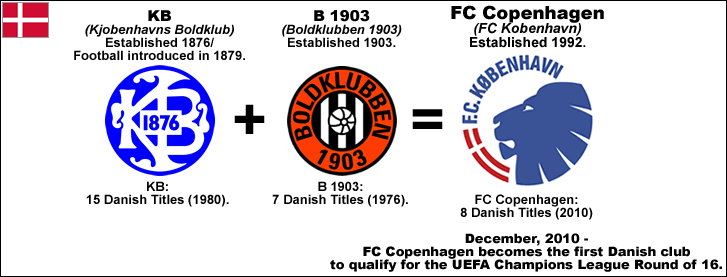
FC Copenhagen have drawn Chelsea for the Round of 16, with the 1st Leg on 22 February in Copenhagen, and the 2nd Leg on 16 March in West London. Judging by Chelsea’s recent form, Copenhagen can be seen as having a fighting chance of advancing. After all, FC Copenhagen beat Manchester United in the CL Group Stage in 2006-07, and Chelsea can’t beat bottom-of-the-table clubs like Wolverhampton Wanderers these days.
…
Last season I posted a map of this round of the competition in December, 2009, right after the draw was held. I decided to hold off a little this season. The CL Knockout Phase still will not be starting for 36 days, but on the Sunday (13 Feb.) before the matches begin on 15 and 16 February, I will re-post the 3 gifs here (the map and the 2 match-ups pages), along with a map of the 2010-11 UEFA Europa League Round of 32 (which will begin on Thursday, 17 February).
…
From Backpage Football.com, from 6 January, ‘Champions League – Reason to be excited‘, by Ger McCarthey.
…
The following gif shows the 8 clubs involved in the first two match days of the 2010-11 Champions League Round of 16, on 15 and 16 February…
AC Milan v. Tottenham Hotspur
Valencia v. Schalke 04
Arsenal v. Barcelona
AS Roma v. Shakhtar Donetsk
Click on box below…

The next gif shows the 8 clubs involved in the second set of match days, on 22 and 23 February…
Lyon v. Real Madrid
FC Copenhagen v. Chelsea
Internazionale v. Bayern Munich
Marseille v. Manchester United
Click on box below…

-
Photo Credits -
AC Milan/San Siro…Dankuna.com, here. RossoneriBlog.com, here.
Tottenham/White Hart Lane…Jazza5 at en.wikipedia.org, here. Daily Mail.co.uk, here.
Valencia/Mestella…A Life In Valencia.com, here. z6.invisionfree.com/Ultras Tlfosi, here.
Schalke 04/Veltins-Arena…VioletaS_gr at Flickr.com, here. ArenaPark.Gelsenkirchen.de, here.
Arsenal/Emirates Stadium…ByrneGroup.co.uk,/Projects, ‘Emirates stadium – Scope of Work [6-photo slideshow]‘, here. DailyMail.co.uk, here.
Barcelona/Camp Nou…kammourewa at Photobucket.com, here. Bing.com/maps Bird’s Eye satellite view, here.
AS Roma/Stadio Olimpico…Bing.com/maps/Bird’s Eye satellite view, here. ASRomaAlive.com, here.
Shakhtar Donetsk/Donbass Arena…Elparadiso19 at en.wikipedia.org (link is to a Donbass Arena gallery, here). Ultras.org.ua, 2010 Shakhtar gallery, here.
Lyon/Stade de Gerland…Bing.com/maps Bird’s Eye satellite view, here. Chasseurdestades.com/France, here.
Real Madrid/Bernebéu…FCB Transfers.blogspot.com, here. Real Madrid Videos, here.
FC Copenhagen/Parken…Virtual Tourist.com, here. MTU.edu, here.
Chelsea/Stamford Bridge…cyberdees at Flickr.com, here. Eco Compact City.org, here.
Internazionale/San Siro…zerozerofootball.com/San Siro (gallery, 30 photos), here. oscar federico bodini at en.wikipedia.org, ‘Curva (stadia)/Italy‘.
Bayern Munich/Allianz Arena…Karl Leidorf at Leidorf.blogspot.com, here. Maximillian Dörrbecker (Chumwa), at en.wikipedioa.org, here.
Marseille/Stade Vélodrome… Projets-Architecte-Urbanisme.fr. fredGLLS at Flickr.com, here.
Manchester United/Old Trafford… ManUtd24.com, ‘Nervous Glazers tell ManUtd players not to wear Green and Gold!’. ManUtdPics.com , (Manchester United/Old Trafford photo).
Thanks to the contributors to the pages at en.wikipedia.org, ‘2010-11 UEFA Champions League‘.
Thanks to E-F-S site, for attendance figures from 2009-10, and for Shakhtar Donetsk current attendance figures. Thanks to ESPN Soccernet for most of the current attendance figures. Thanks to Soccerway.com for FC Copenhagen current attendance figures {Danish Super Liga at Soccerway.com}


